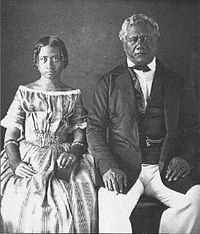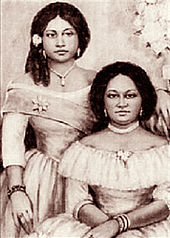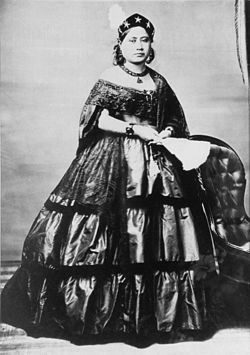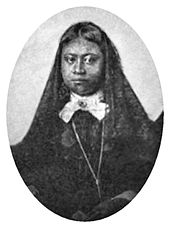- Victoria Kamāmalu
-
For other people with similar names, see Kaahumanu (disambiguation) and Kamāmalu.
Victoria Kamāmalu Crown Princess of the Hawaiian Islands and Kuhina Nui of the Hawaiian Islands 
Hawaiian Head of State Reign November 30, 1863 Predecessor Kamehameha IV Successor Kamehameha V Kuhina Nui of the Hawaiian Islands Reign January 16, 1855 – December 21, 1863
(8 years, 339 days)Predecessor Keoni Ana Successor Kekūanāoʻa Full name Wikolia Kamehamalu Keawenui Kaʻahumanu-a-Kekūanaō‘a, Victoria Kamāmalu Kaʻahumanu IV House House of Kamehameha Father Kekūanāoʻa Mother Kīnaʻu Born November 1, 1838
Honolulu, OʻahuDied May 29, 1866 (aged 27)
Papakanene, Honolulu, OʻahuBurial June 30, 1866[1]
Mauna Ala Royal MausoleumSignature 
Victoria Kamāmalu Kaʻahumanu IV (1838–1866), was Kuhina Nui of Hawaii and its crown princess. Princess Kamāmalu is one of Hawaii's less notable historical figures. She was largely overshadowed by her female contemporaries including her sister-in-law, Queen Emma Kaleleonalani; her schoolmate, Liliʻuokalani whose fame exceeded hers much later on; her half-sister, Ruth Keelikolani, known for her tragedy and large landholding; and her first-cousin-once removed, Bernice Pauahi famous for her legacy to the Hawaiian people, Kamehameha Schools. She was the last true Princess of the House of Kamehameha. Although not agreed upon by most, she was the first female to become the monarch of Hawaii, reigning from for a day in November 30, 1863.
Contents
Family
She was born on November 1, 1838 in Honolulu, two months after Liliʻuokalani. Named Wikolia Kamehamalu Keawenui Kaʻahumanu-a-Kekūanaō‘a[2] and also named Kalehelani Kiheahealani,[2] she was mainly referred to as Victoria Kamāmalu or Kaʻahumanu IV[3], when addressing her as the kuhina nui. She was the only daughter of Kaʻahumanu II and her third husband Mataio Kekūanāoʻa. Through her mother she was granddaughter of King Kamehameha I, founder of the kingdom. Her two brothers were kings of Hawaii as Kamehameha IV and Kamehameha V. She was named after her maternal aunt Queen Kamāmalu, the consort of Kamehameha II, who died in London from the measles. The Christian name Victoria signified the close friendship of the British monarchs and the Hawaiian monarchs for it was Queen Victoria who returned the sovereignty of the Hawaiian Islands to her uncle, Kamehameha III, after the Paulet Affair. Having given away her previous four sons, Kaʻahumanu II refused to give only remaining daughter in hānai to John Adams Kuakini who wanted to take her to raise on the Big Island. She defied customs of the time and personally nursed her daughter.[4] Victoria's mother died not long after her birth. She was the highest female chief in Hawaii at the time. Her kahu (attendants) were John Papa ʻĪʻī and his wife Sarai. They later followed Victoria to school due to her age at the time.[5]
Early life
She was educated at Royal School along with all her cousins and brothers. She was expected from birth to one day succeed to the position of Kuhina Nui if not the office of Monarch, so she was educated by the Cooke with full attention to what political scheme she would play in the near future. In the school, they were permitted to visit with relatives from time to time. When the students fell ill, their kahu and families went to the school and stayed for a while to attend to the patient. Victoria's kahu, John Papa ʻĪʻī, eventually was appointed kahu for all the students at the Chief's Children's School and visited in that capacity, though his political services were in such demand by the court that he was often absent.
Her father Kekūanāoʻa raised her. He was the royal governor of Oahu. In Honolulu her father built her a Greek-revival mansion which was the largest house in the town of Honolulu, or anywhere in Hawaii, at the time. Her father was in debt to the foreigners, so Kamehameha III bought the palace from him. He made it his royal palace and call it Hale Aliʻi (House of the Chiefs) and this was the first Iolani Palace.
She was two months younger than Lydia Liliʻuokalani. They were close friends and aikane or foster-siblings. At the birth of Princess Victoria, Lydia's foster mother Laura Kōnia brought her to Kinau. While Victoria was at her mother's breast, Kinau always preferred to take Lydia into her arms to nurse, and would hand her own child to the woman attendant who was there for that purpose. So she frequently declared in the presence of Kōnia, that a bond of the closest friendship must always exist between her own baby girl and her foster child as aikane or foster-children of the same mother, and that all she had would also appertain to her just as if she had been her own child; and that although in the future Liliʻu might be her child's rival, yet whatever would belong to Victoria should also be Lydia's. This insistence on the part of the mother was never forgotten; it remained in the history of Victoria's girlhood that she would share almost everything with Lydia. On any occasion Victoria visited her aunt Kekāuluohi, Liliʻu would be invited to join her. Victoria was destined to become the first Queen of Hawaii, but it would be Liliʻuokalani who would one day become the first Queen of Hawaii due to Victoria's own death.[6]
As the descendant of a long line of chiefs, stretching back to the days of her mythical ancestor Piʻi, she was of the highest rank. As Mark Twain stated on his visit to Hawaii: The natives have always been remarkable for the extravagant love and devotion they show toward their Chiefs - it almost amounts to worship. When Victoria was a girl of fifteen she made an excursion through the island of Hawaii (the realm of the ancient founders of her race), with her guardian and a retinue of servants, and was everywhere received with wild enthusiasm by her people. In Hilo, they came in multitudes to the house of the missionary, where she was stopping, and brought with them all manner of offerings - poi, taro, bananas, pigs, fowls - anything they could get hold of which was valuable in their eyes - and many of them stinted and starved themselves for the time being, no doubt, to do this honor to a Princess who could not use or carry away the hundredth part of what they lavished upon her. And for hours and even days together the people thronged around the place and wept and chanted their distressing songs, and wailed their agonizing wails; for joy at the return of a loved one and sorrow at his death are expressed in precisely the same way with this curious people.[7]
Kuhina Nui
As the daughter of Kīna‘u, the second Kuhina Nui, and as the highest ranking female chief of the day, it had long been her destiny to assume the responsibilities of the office. While she was a minor, her aunt Kekāuluohi became a place-holder for her niece Victoria using the name Kaʻahumanu III. She died while her niece was still too young, so Kamehameha III appointed John Kaleipaihala Young II, also known as Keoni Ana, the son of John Young as Kuhina Nui. Princess Kamāmalu was appointed as Heiress Presumptive to the title of Kuhina-Nui in 1850, successor to Keoni Ana. Since 1845, by legislative act, the office of Kuhina Nui had been joined with that of the Minister of Interior. Given her young age, it would have been clear to the King, Privy Council, and Legislative Council that Victoria was not suited to be Minister of Interior. Therefore, on January 6, 1855, an act was passed to repeal the earlier legislation. She received her appointment ten days later. An Act to separate the office of Kuhina Nui from that of Minister of Interior Affairs, was approved January 6, 1855, Session of 1854.[8]
She became Kuhina Nui in 1855 mainly due to her brother, Kamehameha IV's, ascension to the throne and the death of her uncle. It is probable that Kamehameha III had meant for Keoni Ana to hold the office till his death. She presided over the King’s Privy Council. She constitutionally assumed the power of the monarch for a day when her brother Kamehameha IV died leaving no legal heirs in 1864. Section II Article 47 of the 1852 Constitution of the Hawaiian Kingdom provided that the Kuhina Nui (Premier), in absence of a Monarch, would fill the vacant office.
"Whenever the throne shall become vacant by reason of the King¹s death, or otherwise, and during the minority of any heir to the throne, the Kuhina Nui, for the time being, shall, during such vacancy or minority, perform all the duties incumbent on the King, and shall have and exercise all the powers, which by this Constitution are vested in the King."
As the first female Head of State of Hawaii, after consulting with the Privy Councilors, she proclaimed in front the Legislature:
It having pleased Almighty God to close the earthly career of King Kamehameha IV, at a quarter past 9 o'clock this morning, I, as Kuhina Nui, by and with the advice of the Privy Council of State hereby proclaim Prince Lot Kamehameha, King of the Hawaiian Islands, under the style and title of Kamehameha V. God preserve the King![9]
Princess Victoria is often overlooked in Hawaiian history and rarely recognized as a Queen of Hawaiʻi. She was literally a "Queen for a day."[10]
Betrothal
She was betrothed to William Charles Lunalilo. Their parents had planned out their marriage from infancy and it was popular among the Hawaiians. The date was set, but interference from her brothers cancelled the wedding.[11][12] They were forbidden to marry by her brothers Kamehameha IV and Kamehameha V. The reason was because their children would have a higher rank or mana than their own lines. This offended Lunalilo so deeply he refused to be buried with Hawaiian royalty, choosing to be laid to rest on the grounds of Kawaiahao Church, alone and away from the Kamehameha dynasty.
Her brother, Kamehameha IV, had tried to split them apart by engaging Victoria to David Kalākaua, and Lunalilo to Lydia Kamakaʻeha.[13]
Scandal
In 1857, a scandal involved her and Marcus Cummins Monsarrat (1828-1870), a married English auctioneer. Monsarrat had been a friend her two brothers and was a friend dinner guest. One night, Prince Lot was informed that Monsarrat was in the Princess' bedroom. He immediately went to her room and caught him the act of "arranging his pantaloons". The enraged Prince told him to leave or he would kill him. When Kamehameha IV found out about the incident, he blamed Lot for not "shooting Monsarrat down like a dog." [14]:79 As Kuhina Nui she had to sign the papers that would banish him from Hawaiʻi:
Whereas, Marcus C. Monsarrat, a naturalized subject of this Kingdom, is guilty of having perpetuated a grievous injury to Ourselves and to Our Royal family, And Whereas, such injury is of such a character as in Our judgement, to authorize and require the expulsion of the said M. C. Monsarrat from Our Dominions...Now, therefore, know that We, in the exercise of the Power vested in Us by virtue of Our office as Sovereign of this Kingdom...do hereby order that the said Marcus C. Monsarrat be forthwith expelled from this Kingdom; and he is hereby strictly prohibited forever, from returning to any part of Our Dominions, under penalty of Death.
Later when Monsarrat returned, the King had him imprisoned and exiled again. Often accounts as Princess Kamāmalu's misbehavement and a love affair between the two, the comtemporary Charles de Varigny defended the princess by saying Monsarrat "had acted so boldly that she called for help".[15]:86 Her brother attempted to marry her to Kalākaua, but she refused; she remained a spinster for the remaining part of her life.[12]
Crown Princess
From her infancy it was expected that she would one day fill the throne, and therefore great importance was attached to her acts, and they were duly observed and noted as straws calculated to show how the wind would be likely to set in her ultimate official life. Princess Victoria was appointed as Heiress-Apparent and crown princess of Hawaiian monarchy by her brother king Kamehameha V in 1863. She could have become queen of Hawaii upon her brother's death but she predeceased him. It was said that she was pro-American and had a close friendship with the American missionaries. She became an accomplished pianist and vocalist, and for many years sat at the melodeon and led the choir of Kawaiahao Church. Robert Wyllie, Minister of Foreign Affairs, once sent for Mr. Ii, and endeavored to get him to use his influence in dissuading the Princess and Mrs. Bernice Pauahi Bishop from further attendance upon the church choirs. He said it was very improper and out of character for Princesses to sing in a choir, and that such personages in England would not do such a thing. The effort was fruitless, however; Victoria continued her former course, and remained faithful to her early friends, the missionaries at Kawaiahao. She was urged to desert them and go over to the Reformed Catholic Church or Anglican Church of Hawaii, but she steadfastly refused.[7]
In 1863, she founded the Kaʻahumanu Society, officially establishing it in 1864, an organization concerned with the welfare of the ill and elderly Hawaiians, originally to nurse the victims of the smallpox epidemic.[14]:188[16]
Death and legacy
She became ill during a party given at the Bishop's residence in Haleākala, Honolulu, in February of 1866. The illness continued and resulted in paralysis in early May.[16] Kamāmalu did not recovered and died on May 29, 1866, at the age of 27.[17] Īī recorded her death in his journal:
Kamāmalu died at 10 a.m. on May 29, 1866, at Papakanene house at Mokuʻaikaua...She was in bed for three weeks before she was taken. On Sunday evenings the members of her two churches pleaded with the Lord, but the trouble was too grave for their petitions. The doctors, too, were unable to make her well. The length of her life was 27 years and seven months.[17]
Her childless death left her brother the king without obvious heirs. The Legislature took $6,000 to defray the funeral expenses of the Princess. Her coffin was fashioned out of the native woods, kou and koa. The former is nearly as dark as ebony; the latter is like fine California laurel, richly grained and clouded with mahogany. Both woods had an iron-like hardness, and were exceedingly close in grain, and when highly polished and varnished nothing in the shape of wood can be more brilliant, more lustrous, more beautiful. There was nothing extraordinary about the fashioning - the planning and construction - of this coffin, but still it was beautiful. The wood was so splendidly burnished, and so gracefully grained and clouded. The silver tablet upon the coffin, upon which is to be inscribed the name and title of the deceased, is to cost $500. This proves the royal state in the Kingdom of Hawaii approaches as near to its European models as the circumstances of the case will admit.[7]
Her funeral also revived many funeral rites of the Native Hawaiians including the kanikau (grief wailing). The wailing lasted for weeks. Many loyal Hawaiians walked as much as 50 miles to pay their last respects to their princess. Writing in high revolutionary fervor of the days immediately following the overthrow of the Kingdom of Hawaii, Professor William DeWitt Alexander remarked:
It is true that the germs of many evils of Kalakaua's reign may be traced to the reign of Kamehameha V. The reactionary policy of that monarch is well known. Under him the "recrudescence" of heathenism commenced, as evidenced by the Pagan orgies at the funeral of his sister. Victoria Kamāmalu, in June, 1866, and his encouragement of lascivious hula hula dancers and the pernicious class of Kahunas or sorcerers. Closely connected with this reaction was a growing jealousy and hatred of foreigners.[18]
Mark Twain was in attendance but was decidedly unsympathetic. He denounced the grief of the Hawaiians as "pagan orgies." Mark twain had sent letters to his newspaper in Sacramento, describing the "Pagan orgies" in such a way that considerable venom crept through his mawkish sentences intended, no doubt, to produce a humorous picture of Princess Kamāmalu's burial. Outsider that he was, Twain lay the blame for the heathen spectacle at the feet of Bishop Staley and the Episcopal Church. They were, in Twain's views, the king's Christian conscience, and as such they should have prevailed upon that monarch to direct the proceedings of his sister's burial in a fashion more acceptable to the foreign community. Twain's attitude reflects the contempt in which the native practices of any people who lived outside the pale of the Anglo-Saxon complex, were held. He knew his reading audience all too well when he fashioned his statements in the guise of ridicule, some of it assuming the same character as the "Hickey, Pokey, Winky Wum..." jewel, which was composed, they say, in honour of King Kalākaua.[18]
Actually, Twain's remarks concerning Victoria Kamāmalu's burial captured some of the truth, but unfortunately he knew nothing of the underlying circumstances, or he might have been more charitable. Princess Kamāmalu had turned away from Western influences after a humiliating scandal involving her love for a married white man. She had retreated to the ways of her ancestors, such as this was possible in the 1860s. Her brother, Kamehameha V, may have been paying his sister the final respect of recognizing the last despairing years of her life for what they were in allowing her burial rites to be celebrated somewhat in line with ancient tradition. On the other hand, the spontaneous kanikau (grief wailing) that began when news of her death spread through the city may have influenced the king to allow native subjects to show grief as they would in honoring the demise of this high ranking chiefess.[18]
Twain's lengthy polemic concerning the burial of the Princess Kamāmalu actually described the proceedings in a more detailed way than any other account that has come down in print. As a sociological document, it reflected certainly the "recrudescence" of native practices that Professor Alexander wrote about in 1893. So far as the Hawaiians were concerned, it can be seen as another thoughtless attack upon a people who at this stage were scarcely able to find a plausible reason for reproducing themselves, or staying alive. The long years of tension between the Hawaiians and white settlers had reached at last a crisis, the main causes of which can easily be traced. Kamehameha V had refused to take the oath of office as king in 1864 until the constitution of 1852 was revised to restore hereditary powers to the throne, and to establish property qualifications for the right to vote and to hold certain offices in the government. In time, the constitution under dispute was revoked. Professor Alexander made direct reference to the revised Constitution of 1864 when he wrote (in language quaintly suggesting a Marx or Eagle's tract) of the "reactionary policy of that Monarch."[18]
Her brother had remained a bachelor throughout his life, intending that she should be his heir. Her death left her brother without an obvious successor. After his brother's death an election was held between Kalākaua and Lunalilo, both former suitors of the princess. Lunalilo easily won the election, yet his reign lasted less than a year.
Her vast landholdings were eventually inherited by her half-sister Keelikōlani who willed them to Bernice Pauahi Bishop and became part of the Kamehameha Schools. The Kaʻahumanu Society went on the wayside after her death, but in 1905, Lucy Peabody reorganized the club, and it continues to this day.
References
- ^ Roger G. Rose, Sheila Conant and Eric P. Kjellgren. "Journal of the Polynesian Society". Polynesian Society. p. 273-304. http://www.jps.auckland.ac.nz/document/Volume_102_1993/Volume_102,_No._3/Hawaiian_standing_kahili_in_the_Bishop_museum%3A_An_ethnological_and_biological_analysis,_by_Roger_G._Rose,_Sheila_Conant_and_Eric_P._Kjellgren,_p_273-304/p1#. Retrieved 2011-9-18.
- ^ a b United States of America: Hawaii: Heads of State: 1810-1898 - Archontology.org
- ^ Kirch, Patrick V. Sahlins, Marshall D. (1992). Anahulu: The Anthropology of History in the Kingdom of Hawaii, Volume 1: Historical Ethnography. University of Chicago Press. ISBN 0226733653. http://books.google.com/books?id=Wi6CuWN3TNEC&ie=ISO-8859-1.
- ^ Katharine Luomala, University of Hawaii (1987). "Reality and Fantasy: The Foster Child in Hawaiian Myths and Customs". Pacific Studies. Brigham Young University Hawaii Campus. pp. 28-29. https://ojs.lib.byu.edu/spc/index.php/PacificStudies/article/viewFile/9449/9098.
- ^ History of Keoua Kalanikupuapa-i-kalani-nui, Father of Hawaii By Elizabeth Kekaaniau Pratt. Page 53
- ^ Hawaii's Story by Hawaii's Queen
- ^ a b c Mark Twain in Sacramento Union - #14
- ^ "Victoria Kamāmalu". Hawaii State government archives web site. http://hawaii.gov/dags/archives/centennial/victoria-kamamalu-and-mataio-kekuanao2018a. Retrieved 2009-10-01.
- ^ Rosalin Uphus Comeau (1996). Kamehameha V: Lot Kapuāiwa. Kamehameha Schools Press. ISBN 0873360397. http://www.ulukau.org/elib/cgi-bin/library?c=ks14&l=en.
- ^ HawaiiansAbroad.com - Hawaiian History
- ^ Alekoki
- ^ a b Kīhei de Silva. "‘Alekoki Revisited". http://apps.ksbe.edu/kaiwakiloumoku/kaleinamanu/essays/alekoki_revisited. Retrieved 2011-09-03.
- ^ Hawaii's Story by Hawaii's Queen
- ^ a b George S. Kanahele (1999). Emma: Hawaiʻi's Remarkable Queen: a Biography. University of Hawaii Press. ISBN 9780824822408. http://books.google.com/books?id=WLtlBNRt_V4C.
- ^ Charles Victor Crosnier de Varigny (1874). Quatorze ans aux îles Sandwich. Hachette et cie. http://books.google.com/books?id=kvsrAAAAYAAJ.
- ^ a b Barbara Bennett Peterson (1984). Notable Women of Hawaii. University of Hawaii Press. p. 427. ISBN 0824808207. http://books.google.com/books?id=rFevAAAAIAAJ.
- ^ a b Kīhei de Silva. "‘Alekoki Revisited". Kamehameha Schools. http://apps.ksbe.edu/kaiwakiloumoku/kaleinamanu/essays/alekoki_revisited. Retrieved 2011-11-12.
- ^ a b c d http://www.janesoceania.com/hawaii_monarchy1/index.htm
External links
- March 27, 1855. New York Times article on her
- Victoria Kamamalu on a Stamp
- Hawai'i's Lost Princess: Princess Victoria Kamāmalu Ka'ahumanu IV
- Victoria Kamamalu "A Worthy Successor" by Julie Stewart Williams
Preceded by
Keoni AnaKuhina Nui of the Hawaiian Islands
January 16, 1855 – December 21, 1863Succeeded by
KekūanāoʻaCategories:- 1838 births
- 1866 deaths
- Kuhina Nui
- Members of the Hawaiian Kingdom Privy Council
- Hawaiian princesses
- House of Kamehameha
- Royal Family of Hawaii
- Heirs apparent who never acceded
- Women of the Victorian era
- Heirs to the Hawaiian throne
- Burials in the Kamehameha Tomb (Royal Mausoleum of Hawaii)
Wikimedia Foundation. 2010.





